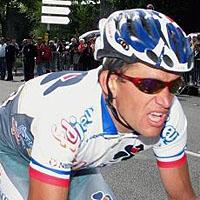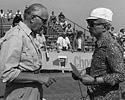
Recently on Cyclingnews.com |
Tales from the peloton, March 14, 2008
Taking shortcuts
Cheating in sports has been around for a long time. The Olympic motto of"Participation is everything" no longer holds true. It is to try to win at all costs – these days with pressure from employers, sponsors, media and the public more than ever. Les Woodland recalls how the cheating ways started in cycling.

|
I never much troubled the judges. I made them stand about in the cold waiting for me, it's true, but I was never in a close finish. Not unless you count half an hour as close.
But I could have won if I'd had a bag of nails. And it wouldn't have been a new idea. In a sport not unknown for cheating, slinging out a handful of something sharp as you ride dates as far back as Paris-Brest-Paris in 1891. In those days it took ages to repair a tyre because it had to be, literally, unbolted from the wheel. Charles Terront was trying to catch the leader but every time he got close, down would go his tyres again. After a while, he and his mechanics took a closer look at the cause. And they saw these weren't rusty, bent nails from a countrymen's boots but sparkling new nails. Straight from the shop. And only when Terront passed the leader, Jiel Laval, did the problem end.
Michelin were so keen to show their tyres could be repaired faster than anyone else's that they laid a bed of nails across the road not once but twice during Paris-Clermont in 1892. Everybody's tyres went down a treat, of course. But only Michelin knew where it would happen and, by happy chance, only Michelin mechanics happened to be in the right place to repair the wheels of Michelin riders. And there happened to be a Michelin masseur as well.
It took a long time for the enthusiasm to die out. Spectators and riders scattered 125kg of nails – the weight of a man and a boy – on just the Tour de France stage from Paris to Nancy in 1905. Henri Desgrange, the organiser, wanted to throw out the 24 riders who ran out of tyres and never got to the finish. Only a strike persuaded him to let all 60 start again.
None of this shocked anyone. It was all in the game. Which is doubtless what Maurice Garin thought when, it seems certain, he extended the concept of cycle-racing to include taking a train in winning the Tour de France in 1904. Maurice Carrère, Henri Gauban and Gaston Tuvache thought the same way two years later. But while it took a while to work out what Garin had probably done, these three had the bad luck to emerge from the station at Dijon… and came across officials who had stopped to look at a map.

|
They got thrown out. But Francis Bouillet and Arsène Alancourt didn't in 1928. When they got dropped, they hitched a lift from a truck. The driver skidded into a ditch. The riders got out, shocked rather than bruised, and finished the stage in a taxi. They even demanded their manager pay the fare. In those days you could drop out of a stage and still start next day, although you didn't get a share of the overall prizes.
Sabotage happened, too. Gustave Garrigou took his bike into his room after the Nîmes stage of the Tour in 1910. He forgot to lock the door and at three o'clock the next morning his front hub exploded. He had to get on his knees in the darkness – stages went through the night – to find the ball bearings.
In 1937 another Frenchman, Roger Lapébie, found moments before a stage through the mountains that someone had sawn halfway through his handlebars. Belgian riders were furious that Lapébie used to hang on to cars over climbs but was never penalised. Persuaded that France wanted a French winner at all costs, word has it that they decided to raise those costs by getting to work with a hacksaw. Within days the Belgians were all back home and Desgrange got his French winner.
There are few easier ways to get over a mountain than by being towed. Dutch riders had a reputation for that in the 1970s, holding the side mirror on one side of team cars while the TV camera and the commissaires were on the other. Sometimes they looped the straps of their food musettes over the mirror. Only better cameras in the helicopters spoiled it for them. But the habit didn't die. Jacky Durand got sent home from the Tour in 2002 for doing the same thing. But there's nothing new – being towed by a wire tied to a car at one end and a cork between the teeth at the other was discovered back in 1904.

|
Michael Rasmussen wasn't the first maillot jaune sent home in mid-voyage. Michel Pollentier in 1978 was caught tricking a dope test with a condom of someone else's urine and a length of tube.
Pedro Delgado 10 years later came close to packing his bags when he took a drug which, were you of a suspicious mind, could hide other drugs. Jacques Goddet, just retired as organiser, was so furious that he wanted Delgado out of the race and leaked the news to French television. But Delgado stayed: the drug had been banned by the IOC but not yet by the UCI.
The last suspicion-free winner of the Tour was Greg LeMond in 1990. Take out Lucien van Impe and Bernard Hinault, neither caught in tests, and there hasn't been a shadow-free winner since Federico Bahamontes in 1959, which was before dope-testing started [in 1966 - ed.] Of 273 riders who have made the Tour podium in Paris, 138 have been at some time implicated in doping, says the Annuaire de Dopage.
Cheating has been with us a long time, hasn't it?
Photography
For a thumbnail gallery of these images, click here
Images by AFP Photo
- Jacques Goddet (l) wanted Pedro Delgado thrown out in 1988 after the Spaniard was found to have taken masking agents. But they weren't banned by the UCI (yet).
Images by Peter Geyer
- Jacky Durand was often in solo breaks but once in a while hung on to big cars as well, costing him to see the Champs-Elysees in 2002.
Images by Makoto Ayano/www.cyclingtime.com
- Michael Rasmussen was the centre of the whereabouts affair as it was initially not clear if he was in Mexico, Italy and if it had anything to do with where he buys his nails.
